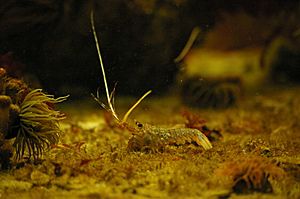Panulirus cygnus facts for kids
Quick facts for kids Panulirus cygnus |
|
|---|---|
 |
|
| Juvenile P. cygnus | |
| Conservation status | |
| Scientific classification |
Panulirus cygnus is a type of spiny lobster. It lives off the west coast of Australia. This lobster is also known as the western rock lobster. It is very important for Australia's fishing industry. In fact, it makes up 20% of the value of all fishing in Australia.
Contents
About the Western Rock Lobster
Western rock lobsters have five pairs of legs. They use these legs to walk on the ocean floor. Female lobsters have small claws on their fifth pair of legs. They also have six smaller pairs of legs near their mouth. Their eyes are on stalks, which helps them see around.
These lobsters can be different colors. Some are brownish-purple, while others are very pale. They have a hard outer shell called an exoskeleton. As the lobster grows, it sheds this shell. This process is called molting. The biggest western rock lobster ever found weighed 5.5 kg (about 12 pounds). Most of them weigh up to 5 kg (about 11 pounds). Their main body shell, called the carapace, is usually 80 to 100 mm long.
Where They Live
You can find Panulirus cygnus along the coast of Western Australia. Their home stretches from Hamelin Bay up to the North West Cape. They also live around islands like the Houtman Abrolhos.
Baby lobsters, called larvae, start their lives in beds of seagrass. As they grow, they move away from the coast. They travel to deeper parts of the ocean and to coral reefs. The Abrolhos Islands are a good example of where they move to.
Fishing for Lobsters
The western rock lobster is a very popular catch. Each year, between 8,000 and 15,000 tonnes of these lobsters are caught. In 2003/2004, the lobsters caught were worth A$248 million. This makes it Australia's most valuable fishery.
This fishery was one of the first in the world to get a special award. It was certified as "ecologically sustainable" by the Marine Stewardship Council. This means that the fishing is done in a way that protects the environment and the lobster population.
People have been catching these lobsters since 1829. That's when the Swan River Colony was first settled. The fishing industry grew as more lobsters were found. The main fishing area became the Houtman Abrolhos islands. These islands are at the edge of the continental shelf. Many adult lobsters live there. In the 1930s, a factory was built on the islands. It was used to can the lobsters caught during the fishing season.
Some people believe that lobsters caught near Dongara taste better. However, scientists have not found any differences in their bodies.
Naming the Western Rock Lobster
The scientific name Panulirus cygnus was first given to this lobster in 1962. A scientist named Ray W. George described it. He saw that it was similar to other Panulirus species. But he also found enough differences to make it a separate species.
The name Panulirus is a bit of a puzzle. It's an anagram of Palinurus. Palinurus was a character in an old story called the Aeneid. His story is a good way to describe how these lobsters live. They start near the coast and then move out to the open sea.
The second part of the name, cygnus, is special. It comes from Cygnus atratus, which is the black swan. The black swan is a symbol of Western Australia. Ray George collected the first official sample of this lobster. He found it in a pool at Rottnest Island at a depth of 1 meter. This sample is kept at the state's museum.
At one point, this lobster was thought to be just a type of another species. But in the 1970s, scientists decided it was its own species. This was important for protecting the fishing industry. Since it's unique to the region, it can't be naturally replaced by lobsters from other places.
People use many common names for this species. These include "western rock lobster," "Australian spiny lobster," and "crayfish" or "crays." Sometimes, people also call them "lobster," "homard," or "yabbie." However, these names are also used for many other types of crustaceans.
Images for kids



